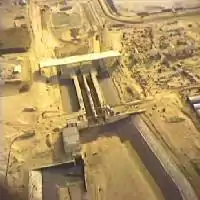Philipsdam | |
|---|---|
 The Philipsdam | |
| Coordinates | 51°39′41″N 4°9′42″E / 51.66139°N 4.16167°E |
| Carries | N257 |
| Owner | Rijkswaterstaat |
| Characteristics | |
| Total length | 7 kilometres (4.3 mi) |
| History | |
| Engineering design by | Deltadienst |
| Constructed by | Several contractors, including Combinatie Zinkcon bv, Aannemers Combinatie Zinkwerken bv, J. Heijmans bv and Baggermaatschappij 'Holland' bv. |
| Construction start | 1976 |
| Construction end | 1987 |
| Location | |


The Philipsdam is a dam constructed as part of the Delta Works in the Netherlands. It separates water of the lakes Krammer and Volkerak from the Oosterschelde. The dam connects the Grevelingendam to Sint Philipsland.[1]
History
A number of alternatives to the final location of the dam and the lock complex were investigated, with an important consideration being the preservation of valuable intertidal areas.[2] The road connection on the south side of the dam required significant research as it runs through vulnerable nature reserves.[3] The construction of the Philipsdam began in 1976 with the construction of a 96-hectare temporary working island on a sandbank known as Plaat van de Vliet.
Eighteen months later, when the island was completed, construction of locks began for inland navigation and yachts. In 1983 the complex of locks Krammer was completed. The dam officially opened on February 2, 1987.
In 1994, a second lock was built for yachts.

Locks
The locks are technically sophisticated because they must avoid the exchange between the freshwater Volkerak and the brackish water of the Oosterschelde. The locks are designed so that there is no influx of saltwater that enters the Volkerak and only a little fresh water in the Oosterschelde. The locks rely on the physical principle that saltwater is denser and sinks, while freshwater rises. By a complex system of pipes and pumps, the saltwater is pumped from the bottom, or conversely, freshwater is pumped from the top, depending on the direction of the ship. Locks on inland waterways are 280 metres long and 24 metres wide.
Environmental impacts
The dam considerably changed the surrounding landscape. Alluvial tidal marsh now supports a rich animal life. An observation hut was installed to facilitate the observation of the many species of birds, such as the pied avocet.
See also
References
- ↑ "Krammersluizen en Philipsdam" [The Krammer Sluices and the Philipsdam]. www.rijkswaterstaat.nl (in Dutch). 29 December 2022. Retrieved 29 December 2022.
- ↑ Anonymus, A. (1975). "Driemaandelijks bericht Deltawerken 071-080 (1975-1979)" [Quarterly Bulletin of the Deltaworks 071-080 (1975-1979)]. Driemaandelijks Overzicht van de Deltawerken (Deltaplan) en Gerelateerde Werken (Dijkversterkingen in Holland, Friesland en Groningen, Lauwerszeewerken). Aanleg Stormvloedkeringen Hollandse IJssel en Oosterschelde. Afsluitdammen Met Caissons en Kabelbaan in Veerse Gat, Brouwershavense Gat, Oosterscheldewerken, Spuisluis Haringvliet, Waterhuishouding van het Deltagebied, Milieueffecten. De Secundaire Werken (Vokerak, Grevelingen, Zandkreek, Zoommeer, Philipssluizen, Krammersluizen, Hellegatsplein). Waterloopkundig Onderzoek en Uitvoeringsmethoden. (in Dutch) (71–080). Retrieved 29 December 2022 – via TU Delft.
- ↑ Anonymus, A. (1977). "Driemaandelijks bericht Deltawerken 081-090 (aug 1977-nov 1979)" [Quarterly bulletin of the Delta Works: 081-090 (August 1977-November 1979)]. Quarterly Bulletin of the Delta Works (in Dutch) (81–090). Retrieved 29 December 2022 – via TU Delft Repository.
External links
The Philipsdam at the Watersnoodmuseum Knowledge Centre Archived 24 January 2021 at the Wayback Machine Information on the Philipsdam from the official Watersnoodmuseum website